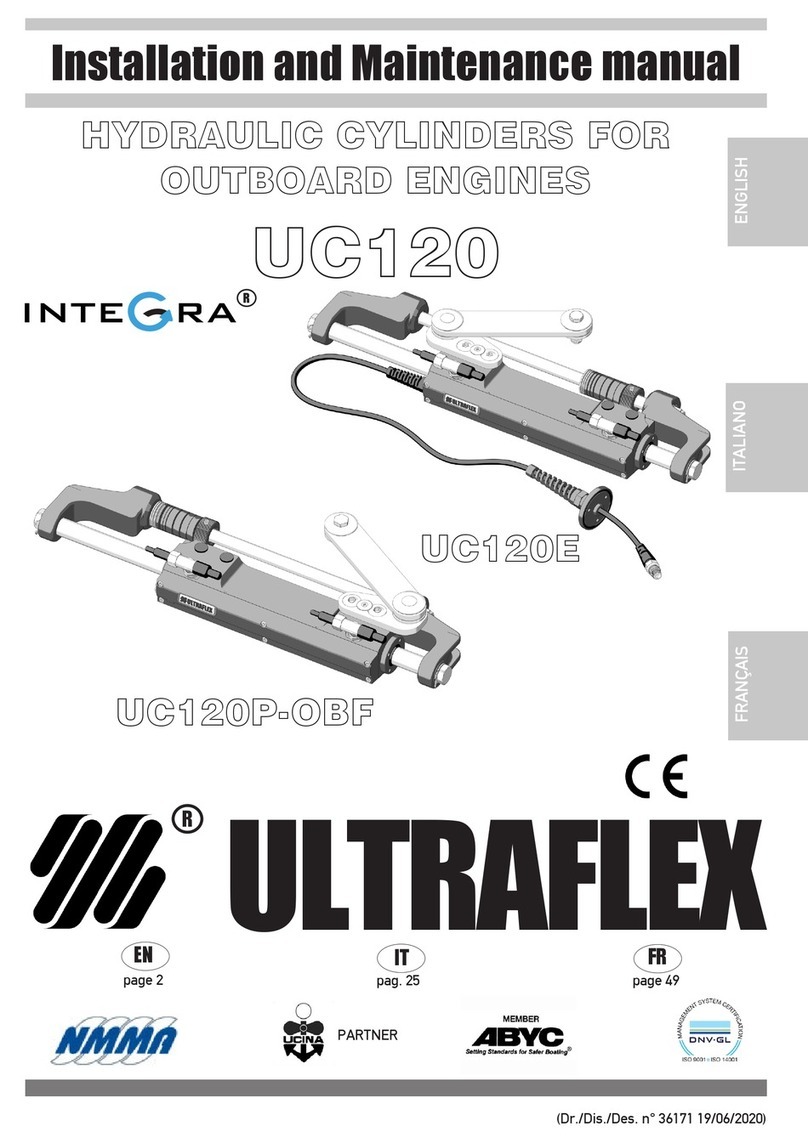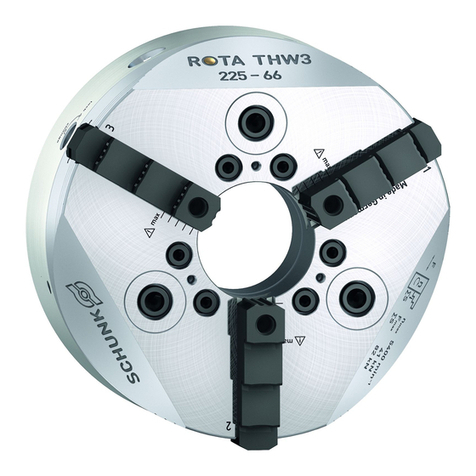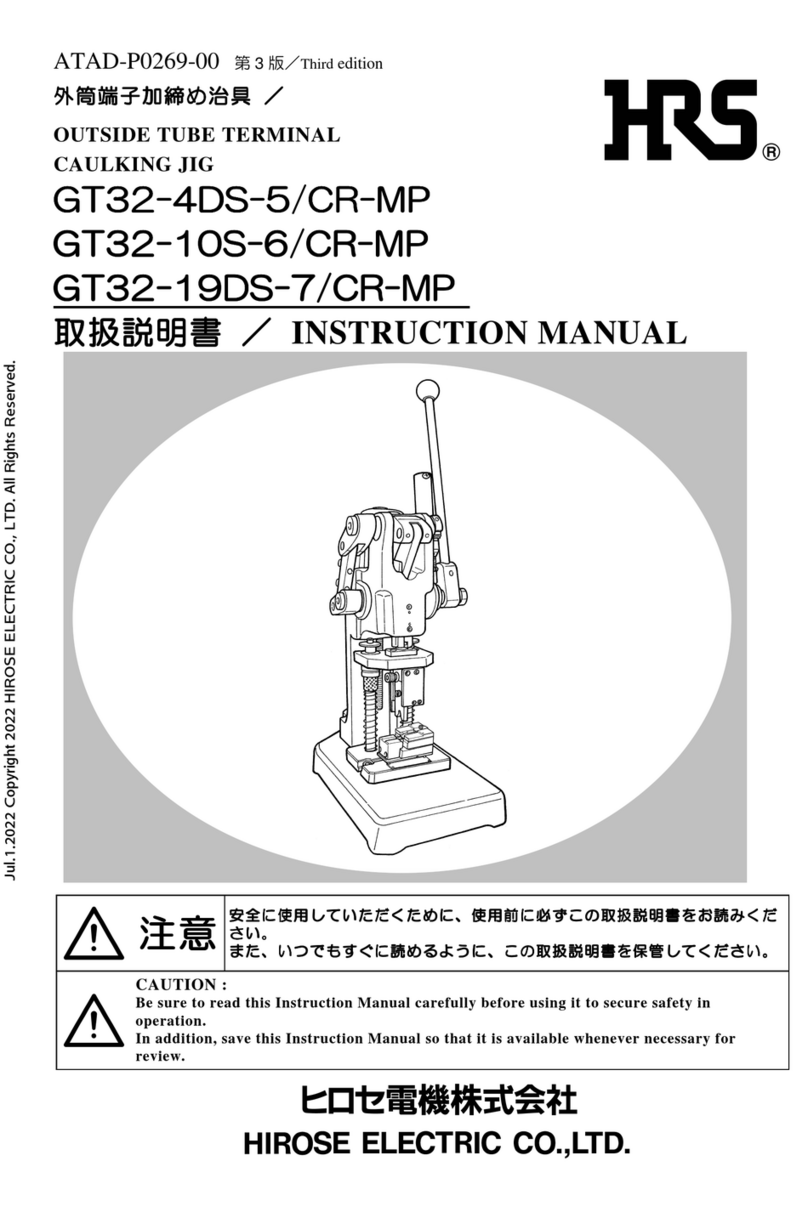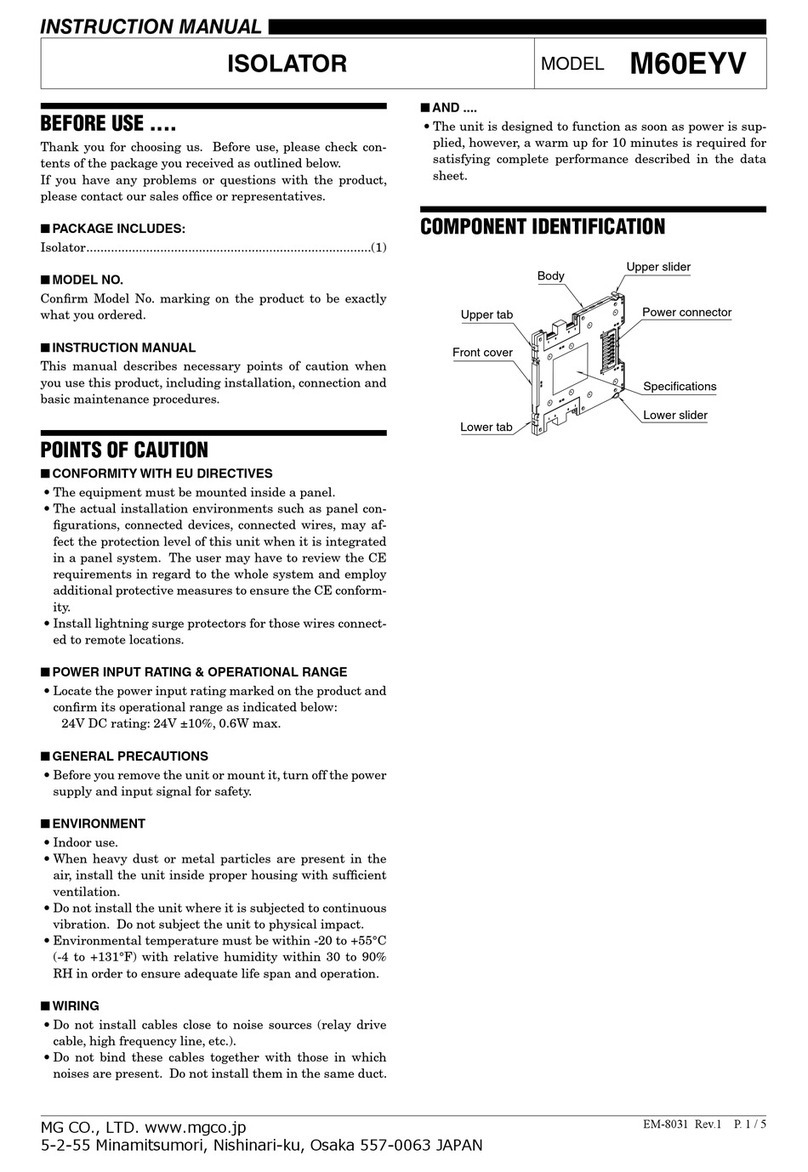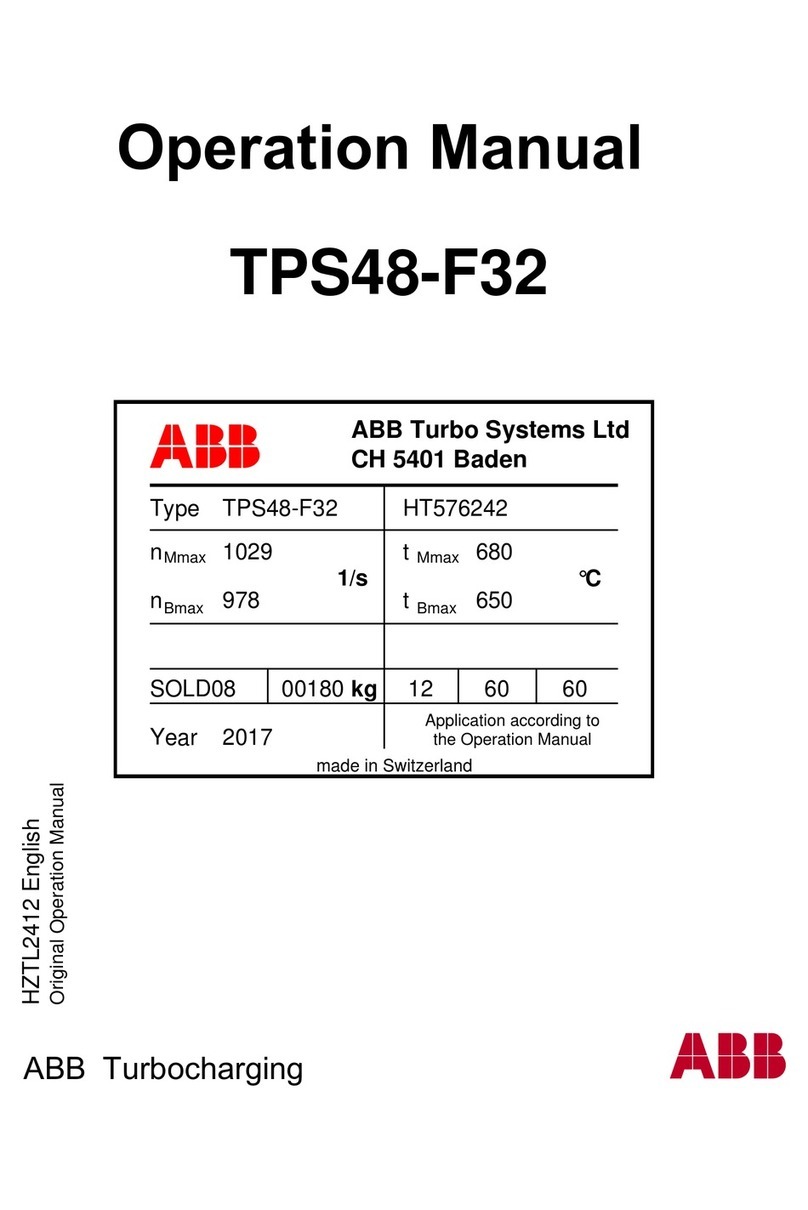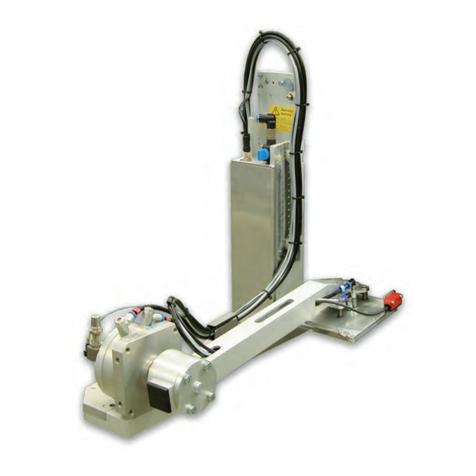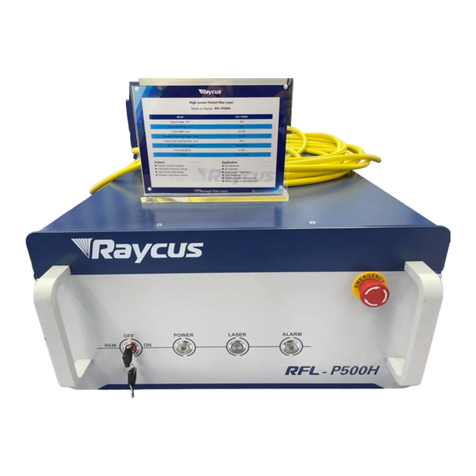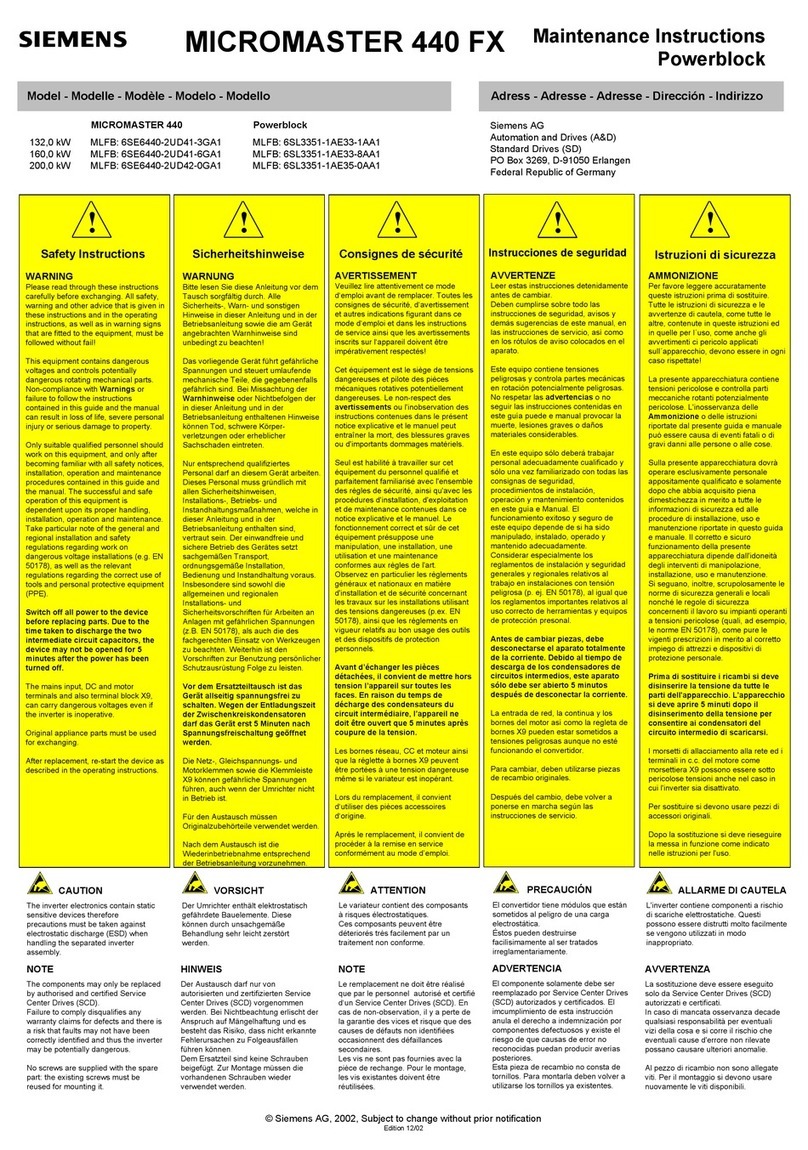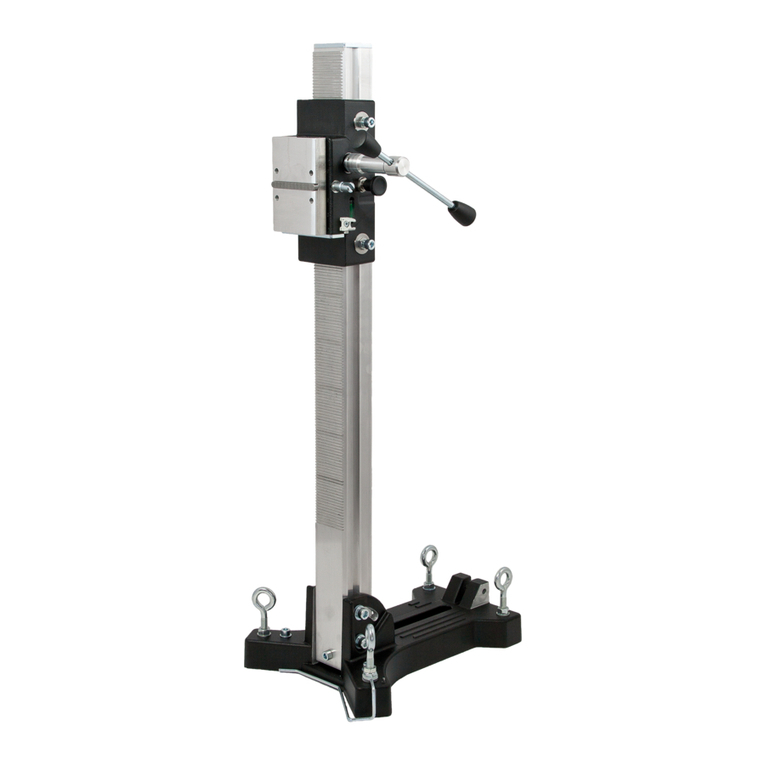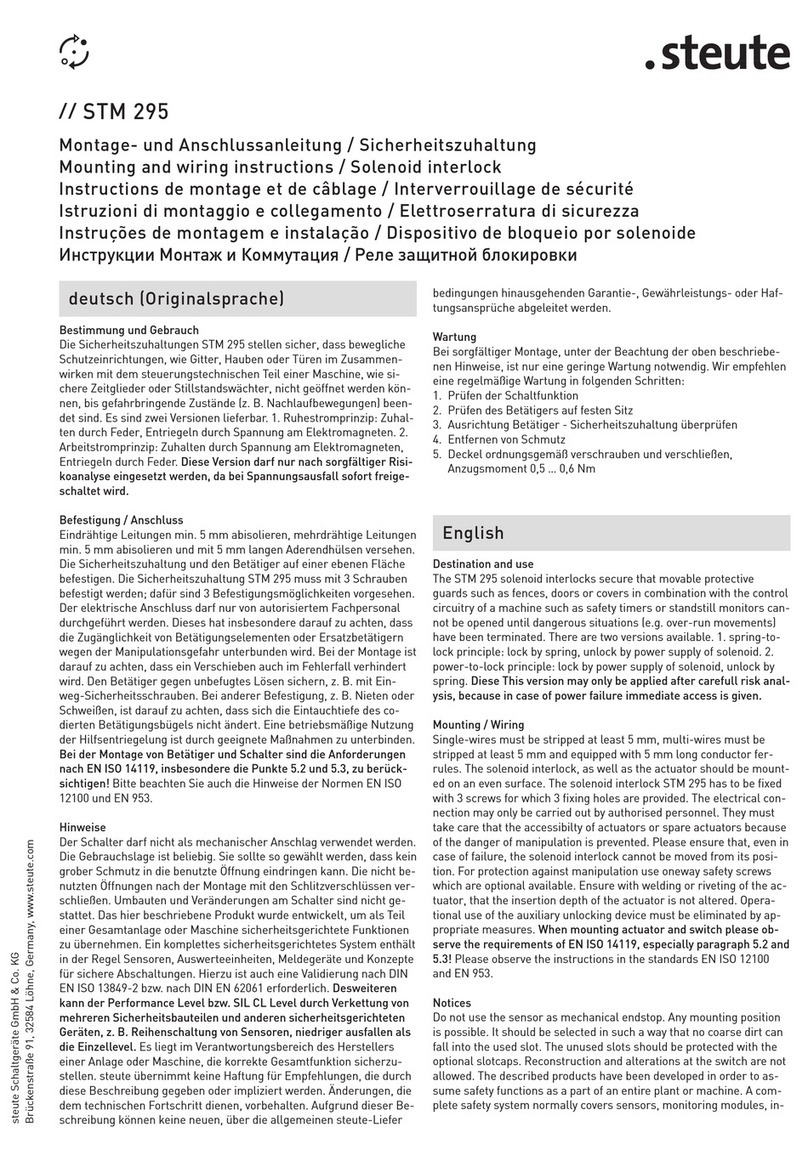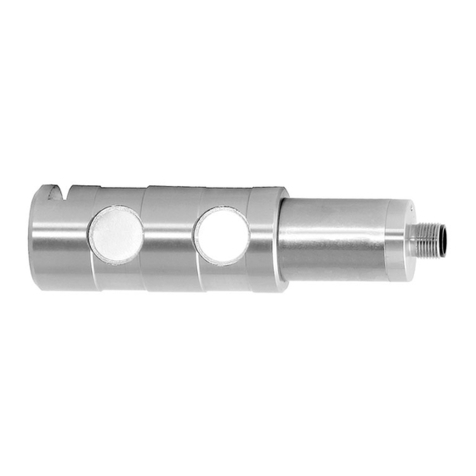GENERAL RADIO COMPANY 874-GAL User manual

OPERATING
INSTRUCTIONS
TYPE
874-GAL
ADJUSTABLE
ATTENUATOR
DESCRIPTION
The
Type
874-GAL
Adjustable
Attenuator
is
of
the
wave-guide-
below-cutoff
type operating
in
the
TE1
~
mode
(inductive
coupling).
The
waveguide
is
excited
by
a
coaxial
trankmission
line,
as
shown
in
Fig
-
ure
1,
and
the
output
voltage
is
induced
in
a
loop mounted
on
a
sliding
plunger.
One
end
of
the
loop
is
terminated
in
a
50-ohm
resistor
and
the
otheris
connected
to
the
output
cable.
This
arrangementmakes
the
output
impedance
of
the
attenuator
approximately
50
ohms.
The
attenuation
is
varied
by
rotating
the
barrel
whichmoves
the
plunger
and
loop
along
the
tube.
The
barrel
is
calibrated
in
relative
attenuation
in
dB.
The
attenu
-
ators
can
be
adjusted
from
the stop
at
the
minimum
attenuation
position,
which
occurs
at
about
-9dB
on
the
calibrated
scale,
to
the
stop
at
the
max
-
imum
attenuation
end
of
the
range,
which
occurs
at
about
140
dB on
the
scale.
Each
revolution
of
the
barrel
changes
the
attenuation
20
dB.
In
most
applications
the
maximum
usable
attenuation
is limited
by
leakage
from
various
parts
of
the
driving
circuit
and
not
by
the
range
of
the
atten
-
uator.
In
this
type
of
variable
attenuator,
as
the
attenuation
is
varied
the
phase
at
the
output
connection
is
essentially
constant
with
respect
to
the
input
signal
phase.
The
method
of
coupling
to
the
coaxialline
permits
the
attenuator
to
beused
as
a
standard
calibratedattenuator
or
as
a
device
to
couple
a
small
amount
of
energy
from
a
high-level
circuit
for
monitoring
or
meas
-
uring
purposes
without
introducing
a
large
discontinuity
in
the
main
line.
The
Type
874-GAL
Coaxial
Attenuator
employs
the
new
Type
874—BL
Locking
Coaxial
Connectors.
These
connectors
can
be
used
interchange
-
ably
with
the standard
GR874~
Connectors.
When
mated
with
another
locking
connector,
a
firm
mechanical
coupling
of
the
two
is
achieved
when
the
coupling
shell
is
engaged.
The
shielding
is
also
improved
sig
-
nificantly,
and,
in
general,
the
leakage
is
reduced
by
at
least
50
dB.
The
“quick-disconnect”
feature
of
thestandard
GR874
Coaxial
Con
-
nectors
is
retained
in
the
locking
type
if the
coupling
shell
is
not
en
-
gaged.
However,
in
this
case
the
shielding
is
not
as
effective.

ERRORS
In
all
waveguide
attenuators,
the
excitation
of modes
other
than
the
desired
one
distorts
the
theoretical
attenuation
characteristic,
particularly
at
low
attenuation
levels.
In
the
Type
874-GAL
Attenuator,the
TM0
1
mode
(capacitive
coupling)
is
the
most
serious
offender.
This
mode
is
attenuated
more
rapidly
with
distance
from
the
source
end
of
the
wave-
guidethan
is
the
desired
mode
and
its
intensity
is
proportional
to
the
volt
-
age
across
the
exciting
line
at
the
coupling
point,while
the
intensity
of
the
desired
mode
is
proportional
to
the
current
flowing
in
the
exciting
line
at
the
point
of
coupling.
The
effect
of
the
undesired
mode
on
the
attenu
-
ation
characteristic
therefore
decreases
as
the
attenuation
increases.
Since
the
output
from
the
attenuator
is
the
sum
of
the
voltage
generated
in
the
loop
by
both
modes,
serious
errors
can
result
if the
voltage
in
the
exciting
line
at
the
coupling
point is
high
compared
to
the
current;
that
is,
if the
impedanceis high.
An
error
correction
procedure
is
required
to
achieve
the
stated
accuracy
for
the
874-GAL
Attenuator.
CORRECTION
PROCEDURES
There are
two
configurations
that
may
be
employed
in
using
the
874-GAL.
First,it
may
be
terminated
in
a
50-ohm
termination
(874-W5OBL)
as shownin
Figure
2,in
which
case
the
special
correction
given
in
Fig
-
ure
2
is
required,
and,
in
addition,
thefrequency
correction
of
Figure
3
is
required.
In
the second
configuration
recommendedto
achieve
the
best
accuracy
above
2
GHz,
the
termination
is
an
adjustable
stub
employed
to
place
a
voltage
minimum
at
the
coupling
points.
The
frequency
correction
graph
of
Figure
3
is
required
only
in
this
case.
The
detailed
procedure
is
given
in
the
following
paragraphs.
If
the
exciting
line
is
terminated
in
its
characteristic
impedance,
for
instance
with
a
Type
874-W5OBL
Termination,
the
error
resulting
from
the
coupling
of
the
TM0
1
modecan
be
corrected
by
using
the
correction
chart
of
Figure
2.
The
~ign
of
the
correction
depends
on
which
end
of
the
exciting
line
is
connected
to
the
source
of
rf
power.
If
the
source
is
con
-
nected
to
the
end
marked
with
the
letter
S,
use
the
correction
curve
labeled
NORMAL
and
subtract
the
correction
found
for
initial
setting
of
the
atten
-
uator
from
the
initial
scale
reading.
Then
subtract
the
correction
found
for
the
finalsetting
of
the
attenuator
from
the
final
scale
reading.
The
trueattenuation
is
the
difference
in
thecorrected
values.
If
the
source
is
connected
to
the
opposite
end,
add
to
the
indicated
values
the
corrections
read
from
the
curve
labeled
REVERSED.
When
these
correction
charts
are
used,
the
indicated
relative
attenuation
is
accurate
within
±(O.015
times
the
difference
+0.2)dB
at
frequencies
up
to
2000MHz.
For
accurate
results
2 GENERAL
RADIO

at
higher
frequencies
for
small
values
of
attenuation,
the
method
outlined
in
the
following
paragraph
shouldbe
used.
To
eliminatethe
correctionand
to
make
the
indicated
relative
atten
-
uation
agree
very
closely
with
the
actual
attenuation
between
—9
and
140
dB
on
the
scale,
the
voltage
across
the line,
at
the
actual
coupling
point,
should
approach
zero.
To
accomplishthis,
connect
an
adjustable
short-
circuiting
stub (Type
874-D2OL
or
-D5OL)
to
the
end
of
the
main
line
op
-
posite
the
source.
Adjust
the
stub
until
a
voltage
minimum
appears
at
the
coupling
point.
To
find
this
stub
adjustment,
substitute
a
Type
874-VRL
Voltmeter
Rectifier
and
a
Type
874-VI
Voltmeter
Indicator,
or
a
Type
874-
TL
Tee
and
a
detector,
for
the
attenuator.
Adjust
the stub
until
the
indi
-
cated
voltage
is
minimized;
then
replace
the attenuator.
(If
the
Type
874-
VRL
is
used,connect
the
end
containing
the
series
resistor,
engraved
R,
to
the
generator.)If
the
frequency
is
changedthe
stub
mustbe
reset,
but
a
frequency
calibration
can
be
marked
on
the
stub,
for
convenience
when
a
number
of
measurements
are
to
be
made.
At
frequencies
below
300
MHz,
a
Type
874-WNL
Short
Circuit can
be
substituted
for
the
stub,
without
fur
-
ther
adjustments.
With
the
Type
874-WNL
Short
Circuit,
accurate
results
can
be
obtained
at
scale
readings
greater
than
zero.
At
frequencies
below
1500
MHz,
the
indicated
attenuation
is
accurate
at
scale
readings
as
low
as
—9
dB,
and,
at
frequencies
between
1500
and
4000 MHz,
readings
above
0
dB
on
the
calibrated
scale
are
accurate
if
the
stub
is
set
as
previously
outlined.
An
alternate
method
of
setting
a
voltage
minimum
at
the
coupling
point,f
or
frequencies
above
1500MHz,
utilizes
the
factthat
the
attenuation
constant
for
the
desired
mode
is
smaller
than
that
of
the spurious
modes.
If
the
attenuator
is set
to
a
relatively
large
value
of
attenuation,
thestub
can
be
properly
set
by
adjusting
it
until
maximum
output
is
obtained
from
theattenuator.
However,
a
voltage
minimum
does
not
occur
at
the
coupling
point
unless
the
effective
sourceimpedance,
seen
looking
back
toward
the
generator
from
the
coupling
point,
is
a
pure
resistance.
When
the
genera
-
tor
and
the
detector
are
not
matched,
the
above
condition
can
be
obtained
by
the
use
of
suitable
pads
(Type
874-G1OL
or
-G2OL)
at
the generator
and
the
detector.
At
the
higher
frequencies
the
attenuation
is
reduced
as
the
wave-
guide
approaches
its
cutofffrequency.
To
correct
for
this effect,
multiply
the
indicated
attenuation
by
the
factor
found
in
the
frequency
correction
graph,
Figure
3,
corresponding
to
theoperating
frequency.
The
impedance
of
the
adjustable
arm
of
the
attenuator
is
nominally
50
ohms.
However,
the
impedance
varies
appreciably
with
frequency,
as
shown
by
the
plot
in
Figure
4
of
the
VSWR
seen
looking
back
into
the
out
-
put
connector
for
a
typical
unit.
The
tolerance
on
the
dc
resistance
of
the
50-ohm
resistor
is
±
10%.
TYPE 874-GAL ADJUSTABLE
ATTENUATOR
3

APPLICATIONS
(1)
The
attenuator
can
be
used
with
a
Type 874-YR
or
-VRL
Volt
-
meter
Rectifier
and
a
Type
874-VI
Voltmeter
Indicator
to
provide
the
level-
monitor
and
variable
attenuator
of
a
signal
generator,
when
combined
with
a
General
Radio
Oscillator.
TheTypes
1362,
1363
and
1218
are
recom
-
mended.
A
block
diagramof
a
typical
setup
is
shown
in
Figure
5.
In
this
case
the
stub
is
adjusted
asindicated
in
a
previous
paragraph
and
the
adjustable
line1
(Type
874-LAL)
is
adjusted
to
obtain
a
maximum
indication
from
the
Type
874-VI
Voltmeter
Indicator.
The
voltage
indi
-
cated
with
the
load
connected
is
the
effective
open-circuit
output
voltage,
and
the
source
impedance
is
accurately
50
ohms.
The
output
can
be
reduced
by
adjusting
the
attenuator;the
actual
voltage
at
any
attenuator
setting
is
the
indicated
number
of
db
below
the
original
calibrating
value.
Sincethe
source
impedance
is
the
same
as
the
characteristic
imped
-
ance
of
the
line,
the
same
effective
open-circuit
voltage
and
source
im
-
pedanceare
obtained
at
the
end
of
any
length
of
50-ohm
line
connected
to
the
outputof
the
voltmeter
rectifier.
If
the
line
is
not
lossless,
the
ef
-
fective
open-circuit
voltage
will
be
reduced
by
the
loss
in
the
line.
(2)
Theattenuator
can
also
be
used
to
measurethe
attenuation
of
a
network
by
the
substitution
method,
as
indicated
by
the block
diagramin
Figure
6.
Readings
of
the
detector
output
and
attenuator
setting
are
first
made
without
the
circuit
under
test
connected.
The
circuit
is
then
inserted
and
the
Type
874-GAL
Adjustable
Attenuator
is
readjusted
to
give
the
same
detector
indication.
Theattenuation
of
the
unknown
circuit
is
thenthe
difference
in
the
attenuator
readings.
The
pads
indicated
are
used
to
make
the
source
and
load
impedances
very
close
to
50
ohms. Oneor
both
can
be
omitted
if
the
source
and
detector
impedances
are
matched.
(3)
For
monitoring
purposes
the
input
line
of
the
attenuator
can
be
connected
in
series
with
the
line
under
test
without
introducing
an
appre
-
ciablereflection
or
loss.
The
changes
in
level
in
the
main
line
can
be
measured
accurately
using
the
attenuator
and
an
uncalibrated
detector
which
may
be
1)
a
Type
874-VRL
Voltmeter
Rectifier
with
a
dc
microammeter
or
an
audio
amplifier
such
as
the
General
Radio
Type
1232-A
Tuned
Ampli
-
fier and
Null
Detector
if the
signal
is modulated
or 2)
if the
signal
is
not
modulated,
the
General
Radio
Type
1241
Heterodyne
Detectors
may
be
‘At
the
lowerfrequencies,
it
may
be
necessary
to
add
lengths
of
Type
874-L30
AirLine
in
series
with
the
adjustable
linetoobtain
the
maximum
output.
4
GENERAL
RADIO

employed.
The
VSWR
introduced
in
a
flat
line
by
the
insertion
of
the
at-
tenuator
is
shown
in
Figure
7.
(4)
It
can
be
used
as
a
phase
inverter
if the
flexible
leg
is driven,
producing
equal
outputs
180°
out
of
phase
at
the
remaining
legs.
RW
~
5.0
~
~30
~
~
H20
~
1.0
0.9
0.8
0.7
0.6
05
~-~U-~ ~
~~, ~GE~ ~ ~ TYPE
874-W5OBL
~
~
HTYPE
874-GAL
~ ~
~
~~L#~H
~t- ~ ~j~i1Jl~J111~
-~
L~
~~
—~
When
source
Is
connected
to
end
of
at-
-~
- -
—
tenuator
marked
S,
subtract
correction
-
labeled
NORMAL
from
reading.
For
t
-
opposite
connection,
add
REVERSED
a
-
-
-
~
correction.
ft
it~t.
1I~
I
II
II
-10
0 0
20 30
40
ATTENUATOR
READING
A,
dB
50 60
874
0.12
Figure
2.
Correction
chart
for
use
with
Type
874-GAL
Adjustable
Attenuator
when
exciting
line
is
terminated
in
its
characteristic
impedance.
Figure
1.
Cutaway
view
of
adjustable
attenuator.
TYPE 874-GAL
ADJUSTABLE
ATTENUATOR
5

874
G-lO
(I)
>
g
0
0.06
0.05
— —
— —
—
-
-
0.04
—
—
—
— —
-
0.03
—
—
—
- -
-
-
/
-
o.or
ii
2
I
III
0.0!
—
E
E
—
—
—
—
—
-
—
O.OOT
0.005
0.00~
—
—
—
—
-
—
~‘
Actual
AttenuatIon
=
(1
-
K)
a
Indicated
AttenuatIon
,
1000
2000 3000 4000
FREQUENCY,
MHz
Figure
3.
Frequency
Correction
Factor.
Figure
4.
VSWR
seen
looking
back
into
out
put
con
-
nector
of
a
typical
Type
874-GAL
Ad.
justable
Attenuator.
FREQUENCY.
GHz
874 G.8
6 GENERAL
RADIO

Figure
6.
Block
diagram
of
setup
for
measuring
the
attenuation
of
a
network.
TYPE
874—R22LA
PATCH
CORD
1209-5
Figure
5.
Block
diagram
of
a
simple
signal
generator
usingthe
adjustable
attenuator
and
other
GR874
Coaxial
Elements.
TYPE
874—D2OL
OR
—D5OL
874
G-14A
TEST
TYPE 874-GAL ADJUSTABLE
ATTENUATOR
7

(I)
>
Figure
7.
VSWR
introduced
in a
flat
line
by
the
insertion
of
a
Type
874-GAL
Adjustable
Attenuator.
SPECIFICATIONS
A
waveguide-below-cutoff
type, useful as a calibrated
attenuator
or
as a sampling device. Calibrated
in
decibels,
on
a
micrometer-type
scale.
Absolute
attenuation
is the
sum
of insertion
loss
and
scale
reading.
Phase
shift
is
essentially constant as
attenuation
isvaried. The
main
line
is a
short
coaxial
section
with
locking
GR874
connectors,
one
end
for
source,
the other for
load.
It introduces
mini
-
mum discontinuity when
inserted
in
a 50-ohm
line.
The
loop
output
is
brought
out
through
three feet of 50-ohm
cable with locking GR874 connector.
Calibrated
Range:
120
dB
(relative
attenuation)
with
input
line
terminated
in
50 0;
129
dB
with input line
terminated
in
adjustable stub to
minimize
the
electric
field at the
coupling
point
(scale
reads
—9
to
120
dB).
Insertion
Loss
(from
input
connector to end of output cable
at 1 GHz, when
signal
source impedance
is
50
0):
With
input
line
terminated
in
50
0,
and
scale
set
at 0
dB,
30.4
dB
±2
dB;
set
at
—9
dB, 17
±2
dB
(settings below 0
are not accurate).
With input line
terminated
in
adjustable
stub
(Which
ex
-
tends the
range
over which the calibration is accurate to
the
—9
dB
scale
setting), 19
±2
dB
minimum.
(Insertion
loss
is
approximately
inversely
proportional
to
frequency up to 1
GHz.)
Insertion
Loss
Directly
Through
Tee:
Negligible.
Accuracy of Attenuation:
Stub-terminated
input,
±(0.0l
times difference
in
attenu
-
ation
reading
+0.2)
dB,
direct-reading.
50-U
terminated
input,
±(0.015
times difference
in
atten
-
uation
reading
+0.2)
dB,
when corrected.
Correction
chart
supplied.
VSWR
Introduced
into Line:
<1.03
at
1
GHz;
<1.12
from 1
to 4 GHz.
VSWR
of
Output:
<4
at 1
GHz;
<5
from 1 to
4GHZ.
Max
Power:
Input power limit
inversely
proportional
to
square root of frequency.
Power
should not exceed 300
W
at 1 GHz. Output power should not exceed
1/2
W.
Patent
No.
2,548,457.
GENERAL
RADIO
COMPANY
*WEST
CONCORD,
MASSACHUSETTS
01781
FREQUENCY.
GHZ
8
74.0.13
Form
No.
0874.0210-I
6/68
Printed
in U.S.A.
Table of contents
